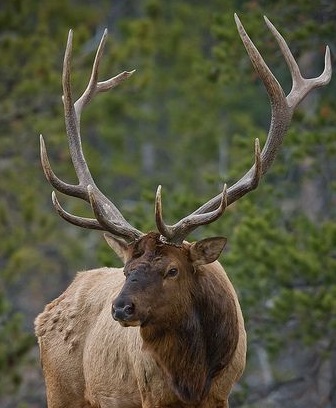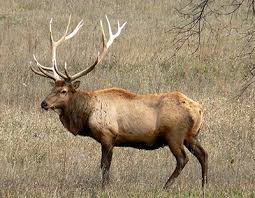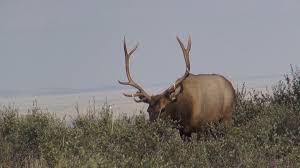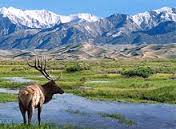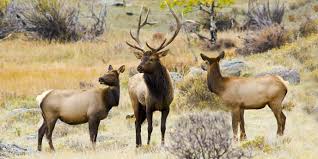The elk, or wapiti, is one of the largest species within the deer family, Cervidae, in the world, and one of
the largest land mammals in North America and Eastern Asia. This animal should not be confused with the still
larger moose (Alces alces) to which the name "elk" applies in British English and in reference to
populations in Eurasia. Apart from the moose, the only other member of the deer family to rival the elk in
size is the south Asian sambar (Rusa unicolor).
Elk range in forest and forest-edge habitat, feeding on grasses, plants, leaves, and bark. Male elk have
large antlers which are shed each year. Males also engage in ritualized mating behaviors during the rut,
including posturing, antler wrestling (sparring), and bugling, a loud series of vocalizations that
establishes dominance over other males and attracts females.
Although they are native to North America and eastern Asia, they have adapted well to countries in which
they have been introduced, including Argentina and New Zealand. Their great adaptability may threaten endemic
species and ecosystems into which they have been introduced.
Elk are susceptible to a number of infectious diseases, some of which can be transmitted to livestock.
Efforts to eliminate infectious diseases from elk populations, largely by vaccination, have had mixed
success.
Some cultures revere the elk as a spiritual force. In parts of Asia, antlers and their velvet are used in
traditional medicines. Elk are hunted as a game species. The meat is leaner and higher in protein than beef
or chicken.
It was long believed to be a subspecies of the European red deer (Cervus elaphus), but evidence from a number
of mitochondrial DNA genetic studies beginning in 1998 show that the two are distinct species. Key
morphological differences that distinguish C. canadensis from C. elaphus are the former's wider rump patch
and paler-hued antlers.
Description
The elk is a large animal of the ungulate order Artiodactyla, possessing an even number of toes on each foot,
similar to those of camels, goats and cattle. It is a ruminant species, with a four-chambered stomach, and
feeds on grasses, plants, leaves and bark. During the summer, elk eat almost constantly, consuming between
4 and 7 kilograms (8.8 and 15.4 lb) of vegetation daily. In North America, males are called bulls, and
females are called cows. In Asia, stag and hind, respectively, are sometimes used instead.
Elk are more than twice as heavy as mule deer and have a more reddish hue to their hair coloring, as well
as large, buff colored rump patches and smaller tails. Moose are larger and darker than elk; bulls have
distinctively different antlers. Elk gather in herds, while moose are solitary. Elk cows average 225 to 241
kg (496 to 531 lb), stand 1.3 m (4.3 ft) at the shoulder, and are 2.1 m (6.9 ft) from nose to tail. Bulls
are some 40% larger than cows at maturity, weighing an average of 320 to 331 kg (705 to 730 lb), standing
1.5 m (4.9 ft) at the shoulder and averaging 2.45 m (8.0 ft) in length. The largest of the subspecies is
the Roosevelt elk (C. c. roosevelti), found west of the Cascade Range in the U.S. states of California,
Oregon and Washington, and in the Canadian province of British Columbia. Roosevelt elk have been
reintroduced into Alaska, where the largest males are estimated to weigh up to 600 kg (1,300 lb). More
typically, male Roosevelt elks weigh around 300 to 544 kg (661 to 1,199 lb), while females weigh 260 to
285 kg (573 to 628 lb). The smallest-bodied race is the tule elk (C. c. nannodes), which weighs from 170
to 250 kg (370 to 550 lb) in both sexes.
Only the males have antlers, which start growing in the spring and are shed each winter. The largest antlers
may be 1.2 metres (3.9 ft) long and weigh 18 kilograms (40 lb). Antlers are made of bone which can grow at a
rate of 2.5 centimetres (0.98 in) per day. While actively growing, the antlers are covered with and protected
by a soft layer of highly vascularised skin known as velvet. The velvet is shed in the summer when the
antlers have fully developed. Bull elk may have eight or more tines on each antler; however, the number of
tines has little to do with the age or maturity of a particular animal. The Siberian and North American elk
carry the largest antlers while the Altai wapiti have the smallest. The formation and retention of antlers
is testosterone-driven. After the breeding season in late fall, the level of pheromones released during
estrus declines in the environment and the testosterone levels of males drop as a consequence. This drop in
testosterone leads to the shedding of antlers, usually in the early winter.
During the fall, elk grow a thicker coat of hair, which helps to insulate them during the winter. Males,
females and calves of Siberian and North American elk all grow thin neck manes; female and young Manchurian
and Alaskan wapitis do not. By early summer, the heavy winter coat has been shed, and elk are known to rub
against trees and other objects to help remove hair from their bodies. All elk have small and clearly defined
rump patches with short tails. They have different coloration based on the seasons and types of habitats,
with gray or lighter coloration prevalent in the winter and a more reddish, darker coat in the summer.
Subspecies living in arid climates tend to have lighter colored coats than do those living in forests. Most
have lighter yellow-brown to orange-brown coats in contrast to dark brown hair on the head, neck, and legs
during the summer. Forest-adapted Manchurian and Alaskan wapitis have darker reddish-brown coats with less
contrast between the body coat and the rest of the body during the summer months. Calves are born spotted,
as is common with many deer species, and they lose their spots by the end of summer. Adult Manchurian wapiti
may retain a few orange spots on the back of their summer coats until they are older. This characteristic
has also been observed in the forest-adapted European red deer.
Diet
Elk are ruminants and therefore have four-chambered stomachs. Unlike white-tailed deer and moose which are
primarily browsers, elk have a similarity to cattle as they are primarily grazers, but like other deer, they
also browse. Elk have a tendency to do most of their feeding in the mornings and evenings, seeking sheltered
areas in between feedings to digest. Their diets vary somewhat depending on the season, with native grasses
being a year-round supplement, tree bark being consumed in winter and forbs and tree sprouts during the
summer. Elk consume an average of 9.1 kilograms (20 lb) of various vegetation daily. Particularly fond of
aspen sprouts which rise in the spring, elk have had some impact on aspen groves which have been declining
in some regions where elk exist.
Distribution
Modern subspecies are descended from elk that once inhabited Beringia, a steppe region between Asia and North
America that connected the two continents during the Pleistocene. Beringia provided a migratory route for
numerous mammal species, including brown bear, camel, horse, caribou, and moose, as well as humans. As the
Pleistocene came to an end, ocean levels began to rise; elk migrated southwards into Asia and North America.
In North America they adapted to almost all ecosystems except for tundra, true deserts, and the gulf coast
of the U.S. The elk of southern Siberia and central Asia were once more widespread but today are restricted
to the mountain ranges west of Lake Baikal including the Sayan and Altai Mountains of Mongolia and the
Tianshan region that borders Kyrgyzstan, Kazakhstan, and China's Xinjiang Province. The habitat of Siberian
elk in Asia is similar to that of the Rocky Mountain subspecies in North America.
Throughout their range, they live in forest and in forest edge habitat, similar to other deer species. In
mountainous regions, they often dwell at higher elevations in summer, migrating down slope for winter. The
highly adaptable elk also inhabit semi-deserts in North America, such as the Great Basin. Manchurian and
Alashan wapiti are primarily forest dwellers and their smaller antler size is a likely adaptation to a
forest environment.
Range and wildlife managers conduct surveys of elk pellet groups to monitor populations and resource use.
Behavior
Adult elk usually stay in single-sex groups for most of the year. During the mating period known as the rut,
mature bulls compete for the attentions of the cow elk and will try to defend females in their harem. Rival
bulls challenge opponents by bellowing and by paralleling each other, walking back and forth. This allows
potential combatants to assess the other's antlers, body size and fighting prowess. If neither bull backs
down, they engage in antler wrestling, and bulls sometimes sustain serious injuries. Bulls also dig holes in
the ground, in which they urinate and roll their body. A male elk's urethra points upward so that urine is
sprayed almost at a right angle to the penis. The urine soaks into their hair and gives them a distinct
smell which attracts cows.
Dominant bulls follow groups of cows during the rut, from August into early winter. A bull will defend his
harem of 20 cows or more from competing bulls and predators. Only mature bulls have large harems and
breeding success peaks at about eight years of age. Bulls between two and four years and over 11 years of
age rarely have harems, and spend most of the rut on the periphery of larger harems. Young and old bulls
that do acquire a harem hold it later in the breeding season than do bulls in their prime. A bull with a
harem rarely feeds and he may lose up to 20 percent of his body weight. Bulls that enter the rut in poor
condition are less likely to make it through to the peak conception period or have the strength to survive
the rigors of the oncoming winter.
Bulls have a loud vocalization consisting of screams known as bugling, which can be heard for miles. Bugling
is often associated with an adaptation to open environments such as parklands, meadows, and savannas, where
sound can travel great distances. Females are attracted to the males that bugle more often and have the
loudest call. Bugling is most common early and late in the day and is one of the most distinctive sounds in
nature, akin to the howl of the gray wolf.
Reproduction and lifecycle
Female elk have a short estrus cycle of only a day or two, and matings usually involve a dozen or more
attempts. By the autumn of their second year, females can produce one and, very rarely, two offspring,
although reproduction is most common when cows weigh at least 200 kilograms (440 lb). The gestation period
is 240 to 262 days and the offspring weigh between 15 and 16 kilograms (33 and 35 lb). When the females are
near to giving birth, they tend to isolate themselves from the main herd, and will remain isolated until
the calf is large enough to escape predators. Calves are born spotted, as is common with many deer species,
and they lose their spots by the end of summer. Manchurian wapiti may retain a few orange spots on the back
of their summer coats until they are older. After two weeks, calves are able to join the herd, and are fully
weaned at two months of age. Elk calves are as large as an adult white-tailed deer by the time they are six
months old. The offspring will remain with their mothers for almost a year, leaving about the time that the
next season's offspring are produced. The gestation period is the same for all subspecies.
Elk live 20 years or more in captivity but average 10 to 13 years in the wild. In some subspecies that suffer
less predation, they may live an average of 15 years in the wild.
Predators and defensive tactics
Wolf and coyote packs and the solitary cougar are the most likely predators, although brown and black bears
also prey on elk. Coyote packs mostly prey on elk calves, though they can sometimes take a winter-weakened
adult. In the Greater Yellowstone Ecosystem which includes Yellowstone National Park, bears are the most
significant predators of calves. Major predators in Asia include the wolf, dhole, brown bear, Siberian tiger,
Amur leopard, and snow leopard. Eurasian lynx and wild boar sometimes prey on Asian elk calves.
Historically, tigers in the Lake Baikal region fed on Manchurian wapiti, and continue to do so in the Amur
region.
Male elk retain their antlers for more than half the year and are less likely to group with other males when
they have antlers. Antlers provide a means of defense, as does a strong front-leg kick, which is performed
by either sex if provoked. Once the antlers have been shed, bulls tend to form bachelor groups which allow
them to work cooperatively at fending off predators. Herds tend to employ one or more scouts while the
remaining members eat and rest.
After the rut, females form large herds of up to 50 individuals. Newborn calves are kept close by a series of
vocalizations; larger nurseries have an ongoing and constant chatter during the daytime hours. When
approached by predators, the largest and most robust females may make a stand, using their front legs to
kick at their attackers. Guttural grunts and posturing effectively deter all but the most determined
predators.



